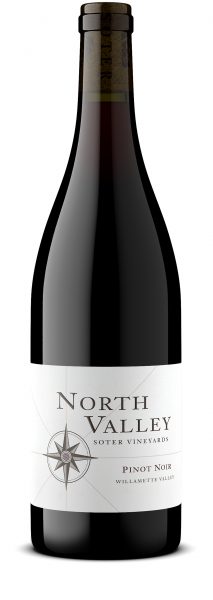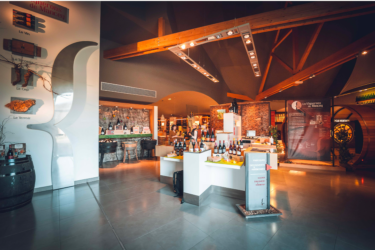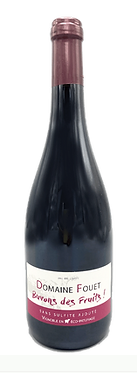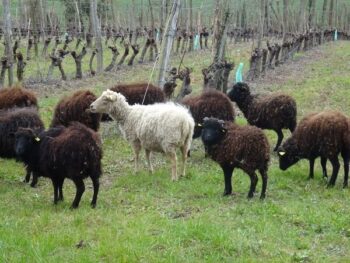CLASSIC CLUB SELECTIONS – November, 2023
- Ziereisen Weisser Burgunder (Pinot Blanc), $23 (DE)
- North Valley Willamette Pinot Noir, $31 (OR)
- Chateau de la Bottiere 2020 Beaujolais Julienas, V. Vignes, $34 (FR)
- Vignerons de Mancey Bourgogne Blanc, $23 (FR)
- Fouet Buvon des Fruits, Loire Valley$26 (FR)
- Francesco Brigatti Vespolina “Maria” Alto Piemonte, $26 (IT)
1. Ziereisen Weisser Burgunder (Pinot Blanc), Germany $23
The Wine
Weisser Burgunder is the German term for Pinot Blanc or White grape of Burgandy (‘Weisser’ = white or blanc, while ‘Burgunder’ = Burgundy, the spiritual center for Pinot). In addition to this wine, Ziereisen produces a Grauer Burgunder (Pinot Gris) and a Spätburgunder (Pinot Noir – the term translates as the Late Burgunder, or the last of the triumvirate to ripen).
This wine is imported by my old friend, Hiram Simon, who not only imports killer wines but also has a knack for describing them. I quite enjoyed his description of Ziereisen (zeer dhie sen) and this wine, so I share it verbatim:
“There is a wonderfully relaxed quality to this wine, curiously evocative of the style familiar from the great Nikolaihof estate in the Wachau. The attack is salty, the texture silky and the flavors just delicious. And yes, 2018 is the “new” vintage. Hanspeter doesn’t believe in rushing wines to market.”
The Winery
“Ziereisen is in the southernmost part of Baden. The soils here are predominantly limestone, which is immediately suggestive of a kinship with Burgundy, especially as there are remarkable climatic similarities between the two regions.

Hanspeter Ziereisen is a huge personality whom everyone seems to know. He and his endlessly good-humored wife, Edeltraud, preside over a compact domaine with an influence out of proportion to its size.
He makes the family’s wines in a resolutely individual way, having long ago given up the notion of conforming to the narrow mind-set of the local wine authorities. Consequently, most of his wines are not submitted for approval as ‘AO Baden’ wines. He would rather they be sold with the lowly designation of “regional” wines, than forfeit his standards. Note, however, the most expensive of Ziereisen’s wines are amongst the dearest wines of Germany. Call this the “Sassicaia Syndrome”.
Without subscribing to the strictest dogmas of “Natural” wine, Ziereisen’s products can be described as nothing but. All vineyard work is manual, all oak barrels are local, no chemicals are employed in the vineyards, fermentations are spontaneous, no wines are filtered, and everything is given time to relax on the lees before bottling and in the bottle before release – even if this runs counter to the cycles of the commercial clock. Each product is given a fanciful name in the local dialect, which is strongly influenced by the strange sonorities spoken across the border in Switzerland. Welcome to the wacky world of Ziereisen. Slides down the throat as easily a hot knife slices through butter.”
2. North Valley Vineyards Pinot Noir ‘Willamette Valley’, Oregon $31
The Wine
The wine begins with classic Oregon Pinot aromas of rose petals, black cherry, plum, and toasted cedar, leading into a palate of wild blueberry and Bing cherry followed by mint and an orange zest that finishes taut and supple.
• Fermented in small open-top vessels
• 20% whole-clusters fermentation
• Aged in French oak, 10% new
• 7,647 cases produced
Drink now through 2028
The Winery
This winery, “North Valley”, was named for small area within the massive Willamette Valley (160 miles long by 45 miles wide) where this wine is from. Ever hear of Dundee Hills, Ribbon Ridge, the Eola-Amity Hills, Yamhill-Carlton District, Chehalem Mountain area, or McMinnville? Yep, all North Valley, and the source of grapes for these wines.
In addition to purchased fruit, the winery manages two Estate Vineyards as well. The first is in Yamhill-Carlton next to some vineyards that are well-loved by fans of Oregon pinot – Shea, Penner-Ash and Beaux Freres! The second estate vineyard is Aegrina Vineyard in the McMinnville AVA. These two sites produce distinctive fruit and contribute depth and complexity to this regional blend.
About Owner/Winemaker: James Cahill
It was in Austin, TX that James developed a passion for fine wine. While working at the Austin Wine Merchant (a Burgundy specialist) the owner and generous clientele introduced James to the greatest wines in the world – Roumier, Claude Dugat, Dujac, Niellon and Raveneau. His work provided the opportunity to visit European vineyards with two esteemed wine importers, Kermit Lynch and Robert Kacher. These are incredible lifetime experiences available to a handful of people!
In the 1990’s he returned to the states as a harvest worker at Beaux Freres where James enjoyed the mentorship of the owner. James worked for Beaux Freres long enough to get married and have two sons while living on the property. In 2001 James was appointed Vineyard Manager and Co-winemaker at Elk Cove (a wine selected for last month’s wine club!) where he transitioned some of the winery’s older vineyard sites to organic farming.
After a relatively short stint, James left Elk Cove in 2002 for the chance to work with Tony and Michelle Soter as Associate Winemaker for Soter Vineyards. He worked with Tony and Michelle to create the North Valley brand in a partnership that has been his sole focus since 2011. Today, James is a veteran of 25 harvest seasons and is mentoring his own successors.
3. Chateau De La Bottiere 2020 Beaujolais Juliénas ‘Vieilles Vignes’, France $34
About the Wine
Perhaps the perfect Thanksgiving wine? Cru Beaujolais offers more complexity and structure than those from an area of Beaujolais outside one of the designated areas.
The wines from Juliénas are typified by youthful aromas of deep cherries that transform into aromas of Cassis over time. The region’s varied soil types mean there are also variations to this rule, depending on where the grapes were grown. Some Juliénas wines lean more to strawberry & spice than cherry while others suggest peach. But regardless of these variations, the region’s wines tend to be fleshier in structure and therefore, among the most age-worthy wines of the Beuajolais village wines.
This is another wine from the visionary Perrachon family, who produce wine from six of the ten Beaujolais villages. Their family has been involved in Julienas since the lae 1800’s, and today they are power players in Beaujolais, known for small-production, hand-crafted wines under multiple labels.
About the Winery
The Beaujolais region is known as the source of light-medium bodied red wines made from the Gamay grape. Located just to the south of Burgundy it was part of the Bourgogne region until politics came into play (as always?!). Today the region is seen as the source for huge quantities of Beaujolais Nouveau and small quantities of very high-end Cru Beaujolais (‘Cru Beau’), a term that covers the 10 designated areas (crus) capable of producing the region’s best wines. From North to South, these would be:
- St-Amour

- Juliénas
- Chénas
- Moulin-à-Vent
- Fleurie
- Chiroubles
- Morgon
- Régnié
- Brouilly
- Côte de Brouilly
A wine from any of these designated Villages does not need to say “Beaujolais” on the label – a ruling these producers sought as a way to distance themselves from the inexpensive Beaujolais Nouveau. A Cru Beaujolais is more serious and able to reward the patient collector with the benefits of aging – beautiful bottle bouquet!
The village of Juliénas may have been named after Julius Caesar, though historical records only suggest such a likelihood. There is no record of this, but we DO know that wine was produced here in Beaujolais 2000+ years ago.
4. Vignerons de Mancey Bourgogne Blanc, France $22
The Wine
For lovers of white wine, and Chardonnay in particular, the white wines of Bourgogne (Burgundy) offer that wonderful combination of oak influence (some more than others, admittedly) and crisp, mouth-watering suggestions of orange rind. A very popular companion for turkey and chestnut stuffing, it is one of the 7-8 wine options available to the 13 blessed souls who will grace our table this year.
In the glass the wine shows a pale golden hue with tinges of green towards its edges. Aromas of Granny Smith apples, pear and citrus (lemon on the initial nose, a slight experience of orange zest on the finish) and some white flower blossoms (jasmine? orange?) and the oak barrels are evident here and on the palate as well.
As far as pairings go, Thanksgiving aside, this is a wine to be enjoyed within a few years of the vintage date, as its freshness is its appeal. Pair it with fish, poultry and even simple pork dishes. Great with salads featuring nuts and blue cheese. And speaking of cheeses, Chardonnay is a friendly pairing partner for a wide range of cheeses. It bridges nicely to soft cheeses like Brie, Camembert and Brillat Savarin, has sufficient acidity to match with fresh goat cheeses, and provides a nice contrast to blue-veined cheese.
The Winery
Les Vignerons de Mancey (the winemakers of Mancey) is a cooperative in the broader region of Burgundy (Bourgogne) and specifically the Mâconnais. Founded in 1929, it is dedicated to promoting its members’ terroirs and famous Burgundy grape varieties: Chardonnay, Pinot Noir, Aligoté, and Gamay. More than 80% of Burgundy wines are produced from two grapes – Pinot Noir for reds and Chardonnay for whites – but their Gamay and Aligoté are also worth a portion of your wine budget. The production of each of these wines must follow the very specific methods and specifications that govern Burgundy AOCs. It’s all about the wine law.
The cooperative feels their small size is their strength, allowing them to create mini cuvees that express the uniqueness of their members. Instead of pooling the fruit into one large production run, the winery crafts individualized bottlings that express… well, they say it best:
“Our job is to highlight the individual terroirs and skills of our members. It is a work of art that could be compared to haute couture.“
5. Fouet Buvons des Fruits Cabernet Franc, Loire Valley (Natural) $26
The Wine
- Organic farming
- No-till
- Use of sheep for weed management
- Natural yeast fermentation
- Carbonic maceration used to add some high-tones to the fruit notes, then stopped after six days
- No fining or filtration
- Unsulfured! (‘sans soufre’)
“to describe this wine as ‘delicious’ is to understate the indecently beguiling beauty of its varietal character.“
 The Name – “Let us drink Fruits” is the virtual translation of ‘Buvons des Fruits’. And once we saw the name and tasted the wine, we agreed it was an apt way to describe this glug-worthy wine – another top pick for the Thanksgiving table. After the U.S. market’s rapturous reception of his inaugural vintage in 2017 of this natty wine, and the rapid depletion of its modest inventory, the annual allocation for the US market has grown with each passing vintage. But the wise lover of Natural wines would not hesitate to bring in a case or two.
The Name – “Let us drink Fruits” is the virtual translation of ‘Buvons des Fruits’. And once we saw the name and tasted the wine, we agreed it was an apt way to describe this glug-worthy wine – another top pick for the Thanksgiving table. After the U.S. market’s rapturous reception of his inaugural vintage in 2017 of this natty wine, and the rapid depletion of its modest inventory, the annual allocation for the US market has grown with each passing vintage. But the wise lover of Natural wines would not hesitate to bring in a case or two.
The classic pairing is with fresh goat cheeses, though aged goat cheeses with a bit of a runny texture pair well with the slight funkiness that this Natty wine provides. A Comte and other Alpine cheeses would work as well.
Drink now through 2025.
The Winery
6. Francesco Brigatti Vespolina ‘Maria’, $29
The Wine
This unique wine is made from the little-known Vespolina grape native to Northern Piemonte. It combines bright red fruit notes with clear herb-and-spice accents. This isn’t by chance – Vespolina is naturally rich in ‘rotundone‘, an aromatic component of some herbs such as Marjoram and also black pepper! The wine exhibits fine tannins and fresh acidity to complement its juicy fruit notes (not to be confused with Juicyfruit gum, which would not be a good thing to find in your wine).
Again, this wine is an ideal companion to invite to your Thanksgiving table.
Vespolina has been described as ‘one of Italy’s best native grape varieties’. But until just recently it was blended into wines made from Nebbiolo. Today, the quality and distinctive character of the best varietal bottlings have encouraged more producers to produce varietal bottlings, despite the grape being difficult to grow.
Brigatti’s Vespolina was planted in the 1980s in acidic soil of morainic origin. These 40+ year-old vines are picked in September and fermented in stainless steel without ever being introduced to wood, a choice made to preserve the wine’s natural freshness. After fermentation the wine spends another week in contact with the skins. The wine is then aged in stainless steel for about six months before bottling.
The Winery
Francesco Brigatti is an exemplary small wine grower in northern Piedmont not far from the southern end of scenic Lake Maggiore. Of course, he makes small amounts of elegant, expressive wines based on the classic Piemontese variety, Nebbiolo. But he also makes delicious varietal bottlings such as this one, from the Vespolina grape. These indigenous red varieties (Uva Rara and Vespolina) are normally blended with Nebbiolo.
The climate is somewhat cooler here in Alto Piemonte than in the better-known Langhe region, with breezes from Monte Rosa (literally, Red Mountain) to the north giving excellent day/night temperature variation. And as always, the unique soils of Alto Piemonte add to the uniqueness of these wines – for the geology geeks, they are ‘acidic morainic clays’ rather than the ‘alkaline calcareous clays’ of the Langa.
Francesco Brigatti: I am the third generation on our farm. I graduated with a degree in agronomy from the University of Turin. For the first few years after graduating, I worked at the university doing clonal selection of grapevines. But when my new boss moved me from the field to a desk job behind a computer, I left the university to dedicate myself to our family estate.
Today I farm a little more than 15 acres, and I use the Integrated Pest Management farming method (owls, sheep, geese…). Our soils are very acidic (pH around 5-5.5) and very rich in potassium and magnesium. What does this mean to the wine drinker? Just know that the soils of this region favor wines with a highly valued savory/earthy character we think you’ll enjoy.’


